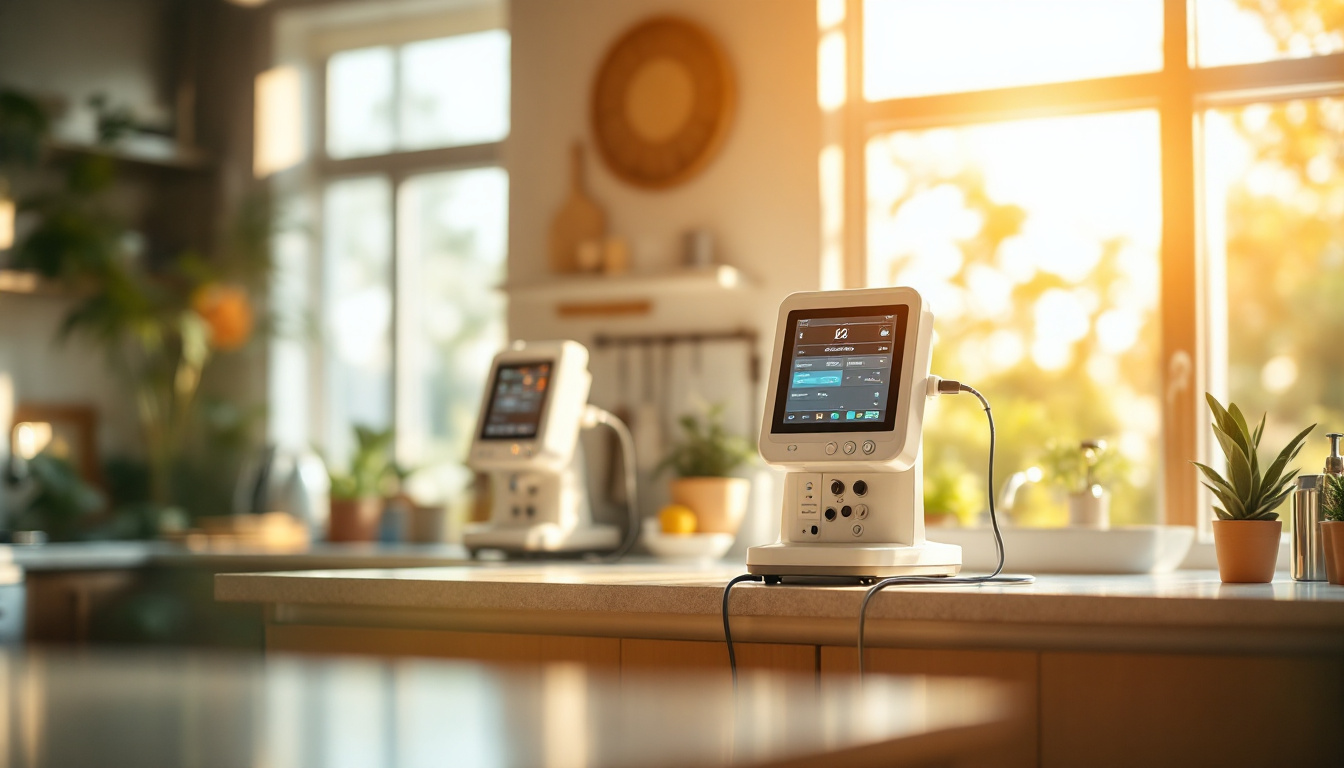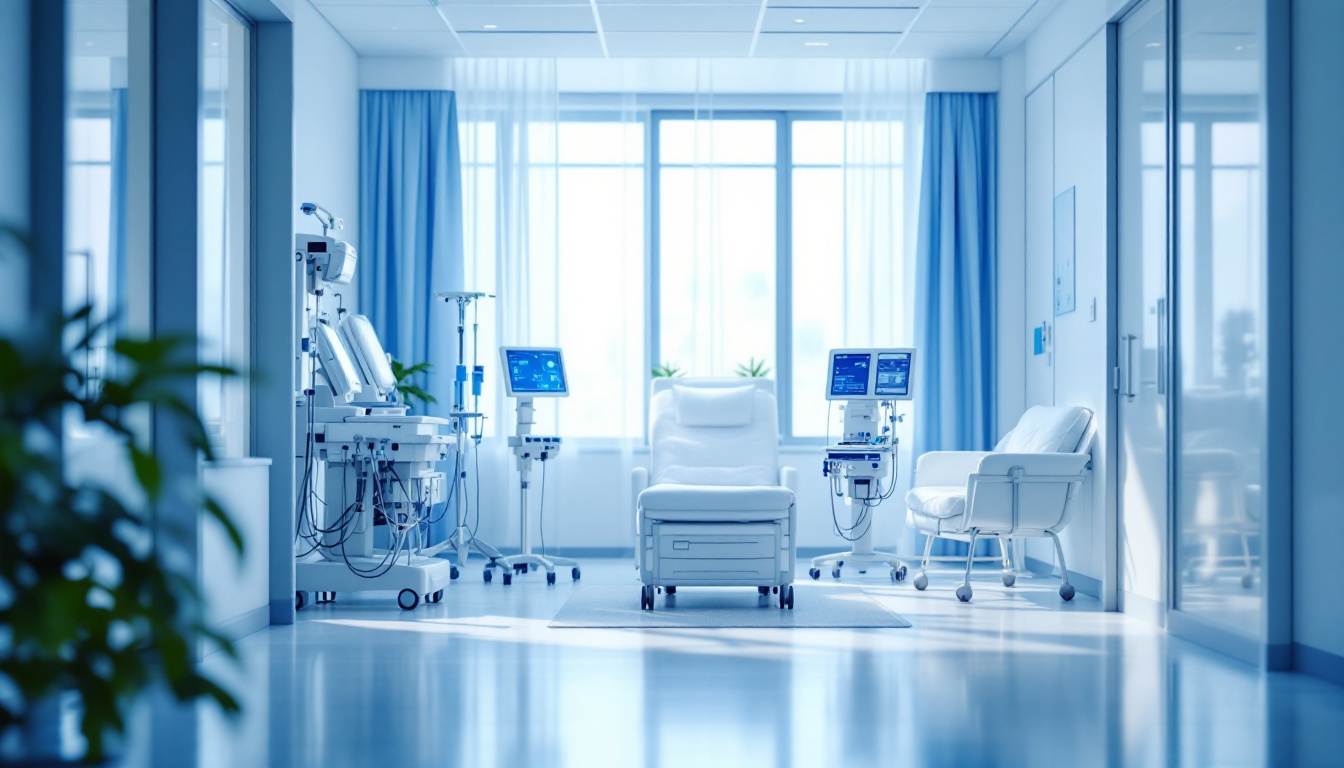Best Practices for TPN Administration in Home Care Settings

Understanding the Essentials of TPN in Home Care
Total Parenteral Nutrition (TPN) is a life-sustaining medical therapy designed to provide complete nutritional support for patients who are unable to meet their nutritional needs through oral or enteral methods. Administered intravenously, TPN delivers a custom mixture of essential nutrients such as carbohydrates, proteins, fats, vitamins, and minerals directly into the bloodstream. This therapy is especially beneficial for individuals with gastrointestinal disorders or severe malnutrition. Moving from hospital to home care settings presents a unique set of challenges and opportunities, necessitating adherence to best practices to ensure safe and effective TPN administration.
The Basics of TPN Administration at Home

What is TPN and Its Administration?
Total Parenteral Nutrition (TPN) delivers essential nutrients directly into the bloodstream for individuals unable to obtain sufficient nutrition orally. This mixture typically includes carbohydrates, proteins, fats, vitamins, and minerals, carefully tailored to meet individual needs, especially for patients facing gastrointestinal challenges.
Protocol for Administering Total Parenteral Nutrition (TPN)
Preparation:
- Ensure a sterile work area.
- Check the TPN bag for clarity and leaks.
- Wash hands thoroughly to prevent infection.
Administration:
- TPN is administered through a central venous catheter.
- Follow the SASH protocol: Saline flush, Administer TPN, Saline flush, and a Heparin flush if prescribed.
- Begin infusions slowly, titrating the rate up over several days while monitoring the patient's response.
Monitoring:
- Conduct daily blood tests during the first week to monitor electrolytes and metabolic responses.
- Adjustments to the TPN formula may be necessary based on these results.
Ongoing Care:
- Regularly flush the catheter to maintain patency.
- Be vigilant for complications such as infections or metabolic imbalances, reporting any abnormalities to healthcare providers promptly.
Transitioning from Hospital to Home Care
Successfully transitioning TPN management from a hospital setting to home requires thorough education and training for patients and caregivers. Preparation involves both establishing a clean area and ensuring that all TPN supplies are complete and correctly stored at refrigerator temperatures. Regular follow-up appointments with healthcare providers are crucial to assess weight, nutrition status, and ensure the patient adapts well to home care. With the right support and resources, patients can effectively manage their TPN, enhancing their quality of life and independence.
Preparing for TPN Administration

Equipment and Preparation Checklist
For a safe and effective Total Parenteral Nutrition (TPN) administration, meticulous preparation is key. Here are essential components to prepare:
- Sterile TPN solution: Check for cloudiness and particles.
- Central venous catheter (CVC): Ensure proper placement and management.
- Infusion pump: Have it ready and functioning appropriately.
- Sterilization materials: Use alcohol swabs to clean surfaces and ports.
- Sharps disposal container: For safe disposal of needles and syringes.
- Documentation: Confirm medication orders with name and dose before preparation.
- Clean workspace: Set up an organized, designated area free of contaminants.
Preparing these items in advance minimizes complications and ensures smooth administration of nutrients.
Importance of Hand Hygiene
Proper hand hygiene is a cornerstone in preventing infections during TPN administration. Here are critical practices:
- Wash your hands thoroughly: Use soap and water for at least 20 seconds before handling TPN supplies.
- Use alcohol-based hand sanitizers when necessary: Especially when soap and water are unavailable.
- Maintain a clean environment: Wipe down surfaces where TPN supplies and equipment will be used.
Adhering to these hygiene protocols significantly reduces the risk of infection, ensuring safe administration of TPN in the home care setting.
What precautions should be taken during TPN administration?
During TPN administration, it is essential to follow strict hygiene protocols, including thoroughly washing your hands before handling TPN solutions and supplies. Always check the expiration date of TPN solutions, inspect them for leaks, and ensure the solution is clear and unclouded before use. Do not adjust the dosage or frequency of TPN without consulting your healthcare provider, and ensure the solution is warmed to room temperature before administration after being refrigerated. Monitor the IV site closely for signs of infection, and seek medical assistance immediately if you experience symptoms like dizziness or if the IV becomes dislodged. Consistent follow-up care is crucial, so attend all appointments and utilize available health resources if you encounter any issues with TPN.
Administering TPN Safely at Home

How is TPN administered at home?
Home Total Parenteral Nutrition (TPN) involves a systematic process designed to ensure that patients receive their required nutrients while minimizing risks.
- Preparation of Supplies: Before starting, patients must prepare all necessary supplies, including pre-packaged TPN solutions, sterile syringes, and hand sanitizers. Ensuring that all equipment is clean and organized is crucial.
- Temperature Check: TPN bags should be removed from the refrigerator 2-4 hours prior to administration to allow the solution to reach room temperature. This can help facilitate proper infusion rates and decrease potential complications.
- Infusion Process: The infusion uses a PN pump to deliver TPN directly into a central line located in a large vein, often near the collarbone. This method helps prevent the irritation associated with using peripheral veins for concentrated solutions.
- SASH Protocol: Adhering to the SASH protocol (Saline flush, Administer medication, Saline flush, Heparin flush if prescribed) helps ensure the solution is properly delivered, reduces risks, and maintains catheter patency.
- Monitoring: Patients should routinely monitor vital signs, such as weight and temperature, and be vigilant for any signs of complications which include catheter-related issues.
The role of the caregiver
The caregiver plays a vital role in home TPN management. Proper training ensures they are equipped to assist and support the patient. Key responsibilities include:
- Education: Caregivers should understand the TPN preparation and administration process to aid patients effectively.
- Monitoring: Regular monitoring of the patient’s condition can help identify adverse symptoms early, increasing the chance of timely medical intervention.
- Supporting Hygiene Practices: Caregivers need to emphasize appropriate handwashing techniques and maintaining a clean environment when handling TPN supplies, reinforcing the commitment to infection prevention.
The successful administration of TPN at home relies heavily on the coordinated efforts of patients and caregivers, underscoring the importance of collaboration in managing this life-sustaining therapy.
Monitoring and Managing Potential Complications

Identification of Adverse Symptoms
Patients on Total Parenteral Nutrition (TPN) must vigilantly monitor for any adverse symptoms that may arise. Recognizable signs include:
- Fever: This could indicate an infection.
- Pain around the catheter: Unusual discomfort may suggest issues with the catheter site.
- Difficulty flushing the catheter: This could indicate a blockage.
- Changes in vital signs: Any sudden changes should prompt immediate contact with a healthcare provider.
Prompt identification of these symptoms facilitates early intervention, which is crucial for maintaining health during home TPN therapy.
Routine Checks and Monitoring
Patients need to establish a routine for monitoring their health status regularly. Key practices include:
- Frequent temperature checks to detect fever.
- Keeping track of weight to monitor for sudden gains or losses.
- Regular testing of blood sugar levels as TPN can affect glucose metabolism.
- Routine blood tests to monitor electrolyte balance, liver function, and nutrient levels must be scheduled, particularly in the initial weeks at home.
The systemized approach to patient assessments and routine checks helps mitigate risks associated with TPN complications. With the right monitoring protocols in place, patients can maintain their nutritional intake effectively while minimizing health risks.
What is the most appropriate way to administer TPN?
The most appropriate way to administer Total Parenteral Nutrition (TPN) is through central venous catheters, as this allows for the delivery of highly concentrated nutrient solutions directly into a large central vein. TPN is indicated for patients who cannot receive nutrition enterally due to conditions such as Crohn's disease, cancer, or gastrointestinal anomalies. Careful monitoring is essential to prevent complications, including infections, blood clots, and liver disease. TPN solutions are tailored to meet individual patient needs, taking into account age, organ function, and specific nutrient requirements. Proper sterile technique and adherence to protocols are crucial during administration to mitigate risks and ensure patient safety.
Equipment Needed for Home TPN
What equipment is necessary for home TPN?
To safely administer Total Parenteral Nutrition (TPN) at home, specific equipment is crucial. This equipment provides patients with the nutrients they need directly into their bloodstream while minimizing the risk of infections.
Central Line and PN Formula
- Central Line: A central venous catheter (CVC) is vital for TPN, as it allows access to a large vein for effective nutrient delivery.
- PN Formula: The parenteral nutrition solution, tailored to individual needs, typically includes carbohydrates, proteins, fats, vitamins, and minerals.
Infusion Pump
- Infusion Pump: This device controls the flow of the TPN solution, ensuring it is delivered at the prescribed rates safely.
What sterilization tools are essential?
In addition to the TPN solution and delivery devices, various sterilization tools enhance safety during administration:
- Sterile Needles and Syringes: For drawing up medications or adjusting the TPN formula, using sterile equipment is critical to minimize contamination.
- Alcohol Swabs: Essential for disinfecting the catheter and surrounding areas before accessing the line.
- Gloves and Disposal Containers: Maintaining clean working conditions requires using disposable gloves and proper sharps disposal containers for used needles and syringes.
| Equipment Type | Purpose | Importance |
|---|---|---|
| Central Line | Nutrient delivery | Access to large veins |
| PN Formula | Provides essential nutrients | Customized for patient's needs |
| Infusion Pump | Controls flow of TPN | Ensures safe nutrient delivery |
| Sterile Needles/Syringes | Safe medication administration | Prevents infections |
| Alcohol Swabs | Disinfects surfaces | Reduces contamination risk |
Essential Nutrients Delivered Through TPN
Components of a TPN Solution
Total Parenteral Nutrition (TPN) provides a comprehensive mix of nutrients directly into the bloodstream, ensuring individuals who cannot consume food receive all necessary dietary components. A typical TPN solution contains:
| Nutrient Type | Examples | Purpose |
|---|---|---|
| Carbohydrates | Dextrose | Provide a primary source of energy for body functions. |
| Proteins | Amino acids | Essential for tissue repair, immune function, and maintaining muscle mass. |
| Lipids | Lipid emulsions | Offer concentrated energy and essential fatty acids, which aid in hormonal production and cell structure. |
| Vitamins and Minerals | Various | Support metabolic processes and overall health. |
| Electrolytes | Sodium, potassium | Maintain fluid balance and nerve function. |
Customization Based on Patient Needs
The formulation of TPN is not one-size-fits-all; it is tailored to each patient's unique medical condition and nutritional requirements. Healthcare professionals evaluate factors such as caloric needs, existing health issues, and laboratory values to customize TPN solutions effectively.
Preparation is often done by a regulated compounding pharmacy, where experts ensure that each bag meets the specific nutritional needs of the patient. This personalized approach plays a critical role in optimizing health outcomes and enhancing the quality of life for individuals relying on TPN.
Maintaining Hygiene and Safety
Hand Hygiene and Workspace Cleanliness
Maintaining strict hygiene during Total Parenteral Nutrition (TPN) administration is paramount to preventing infections. Before engaging in any procedure, healthcare providers and patients alike must wash their hands thoroughly with soap and water for at least 20 seconds. This practice should be followed every time TPN supplies are handled.
Setting up a clean, designated workspace for TPN preparation is also essential. All supplies should be organized and kept in a sanitized area to minimize contamination risks. This designated area should be free from distractions and should allow enough space to work while adhering to hygiene protocols.
Use of Sterile Supplies
Utilizing sterile supplies is another crucial aspect of TPN administration. It is critical to use sterile syringes, needles, and catheters to avoid introducing pathogens into the bloodstream. Additionally, before using the TPN solution, healthcare providers must inspect it for cloudiness or particles, ensuring that only safe, uncontaminated solutions are administered.
Following these steps—rigorous hand hygiene, organized workspace, and strict adherence to using sterile supplies—enables safe and effective administration of TPN, ultimately securing the patient’s health during treatment.
Recognizing and Preventing Infections
Signs of Infection
Infections are a significant concern for individuals receiving Total Parenteral Nutrition (TPN). Recognizing early signs is crucial for timely intervention. Patients and caregivers should be vigilant for symptoms such as:
- Fever: A temperature above normal can indicate infection.
- Severe pain: Pain around the catheter insertion site may suggest an underlying issue.
- Redness or swelling: Inflammation at the catheter site can signal infection.
- Flushing difficulties: If flushing the catheter becomes troublesome, this could hint at a blockage caused by infection. Monitoring these signs allows for prompt action and communication with healthcare providers.
Preventive Measures
Preventing infections during TPN therapy is paramount. Essential practices include:
- Hand Hygiene: Washing hands before handling TPN equipment drastically reduces infection risk. This includes scrubbing with soap for at least 20 seconds.
- Sterile Equipment: All supplies used for TPN should be sterilized and stored properly to minimize contamination risks.
- Central Line Care: Regular cleaning of the central venous catheter and application of appropriate dressings further protect against infections.
- Monitoring Procedures: Consistent monitoring of temperature, weight, and overall well-being helps identify potential issues early.
Implementing these strategies promotes safer TPN administration. Caregivers and patients must be educated on these protocols to work effectively against infection risks.
Patient Education and Support Systems

Training and Educational Resources for Patients and Caregivers
Effective patient education is the cornerstone of successful home parenteral nutrition (HPN) management. Patients and their caregivers must receive thorough training on how to administer Total Parenteral Nutrition (TPN) safely. Educational materials should be clear, concise, and available in multiple languages to cater to diverse populations.
Resources often include detailed guides on TPN preparation, maintenance of sterilization practices, and recognizing signs of complications. Support organizations and healthcare providers collaborate to provide these comprehensive educational tools, ensuring that individuals are well-prepared for TPN administration at home.
Importance of Effective Communication
Communication between patients, caregivers, and healthcare providers is essential. Patients should feel comfortable discussing any concerns or symptoms they may encounter, such as fever or discomfort around the catheter. Regular follow-ups with healthcare professionals help assess nutritional needs and monitor for potential complications.
A successful transition from hospital to home care requires clear communication lines. Caregivers must also be trained to troubleshoot any issues that arise with the infusion equipment or the TPN solutions. Furthermore, ensuring that patients understand how to schedule required check-ups allows for an ongoing dialogue that supports their health and nutrition needs.
| Education Aspect | Importance |
|---|---|
| Training on TPN administration | Empowers patients and reduces risks |
| Clear instructional materials | Enhances understanding and compliance |
| Open communication with healthcare | Addresses concerns quickly and maintains health |
| Regular check-ups | Monitors complications and adjusts treatment plans |
| Caregiver involvement | Supports patient confidence and safety during TPN |
Adhering to Medical Guidelines and Protocols
Institutional Guidelines
Adhering to established institutional guidelines is essential for the safe administration of Total Parenteral Nutrition (TPN). These guidelines help ensure that healthcare providers follow standardized practices to prevent complications and ensure patient safety. Key components of these guidelines include protocols for preparation, administration, and storage of TPN solutions.
Adaptation to Individual Health Conditions
Individual health conditions play a significant role in customizing TPN protocols. Each patient’s nutritional needs are evaluated through thorough assessments that consider their medical history, current health status, and specific nutrient requirements. For example, a patient with short bowel syndrome may need a different formulation compared to someone with chronic diarrhea.
Safety Measures and Monitoring
In addition to established protocols, continuous monitoring of vital signs, blood work, and patient-reported symptoms is crucial. Effectively monitoring for side effects such as hyperglycemia or metabolic imbalances can ensure timely interventions.
Table: Key Considerations in TPN Protocols
| Consideration | Description | Importance |
|---|---|---|
| Nutritional Assessment | Evaluate caloric and protein needs based on health status | Ensures tailored nutrition delivery |
| Sterility Protocol | Follow hand hygiene and equipment sterilization steps | Reduces risk of infections |
| Adverse Effect Monitoring | Regular checks for signs of complications like fever or rash | Enables early intervention for health concerns |
| Individualization | Customize TPN formulations based on specific health needs | Optimizes therapeutic outcomes and patient comfort |
Interdisciplinary Care Coordination
Role of Healthcare Providers
Effective management of Total Parenteral Nutrition (TPN) at home requires a team of healthcare providers. Physicians, registered dietitians, nurses, and pharmacists collaborate to assess the patient's nutritional needs, customize the TPN formula, and provide ongoing monitoring.
This team ensures that all aspects of the patient’s condition are addressed, ranging from nutritional intake to potential complications, such as infection or metabolic abnormalities, which can arise during TPN therapy. The physician typically oversees the overall plan, while dietitians focus on tailoring nutrient composition and monitoring lab results to track electrolyte and vitamin levels.
Effective Communication Among Care Teams
Clear and continuous communication among care team members is essential to ensure optimal outcomes for patients receiving home TPN. Regular check-ins, updates on the patient's condition, and sharing lab results help the team make informed decisions about any necessary changes in the TPN regimen.
Providing education and training for both patients and caregivers is also vital. They must understand how to manage the TPN administration process effectively. This includes recognizing signs of potential complications, ensuring sterility, and properly caring for the central venous catheter used for TPN.
Utilizing methods like electronic health records (EHR) can facilitate real-time sharing of patient information and promote a seamless care experience, enhancing both safety and quality of life for patients on home TPN.
Adjusting to Quality of Life Enhancements
Integrating TPN into Daily Life
Adjusting to Total Parenteral Nutrition (TPN) at home can be a significant change for patients. However, with the right preparation and education, it can integrate smoothly into daily routines. Many patients find a schedule that suits their lifestyle—often opting for nighttime infusions over 8-12 hours to minimize daytime disruption. This allows for participation in normal activities during the day, including work and social engagements.
Benefits of Home TPN
Home TPN provides essential nutrition to individuals who cannot meet their dietary needs through eating alone. Benefits include:
- Empowerment: Patients manage their care, boosting confidence and independence.
- Improved Quality of Life: With proper training and resources, patients can enjoy an active lifestyle, maintain relationships, and even return to work.
- Personalized Support: Through follow-up appointments and resource availability, patients receive tailored advice to monitor their health effectively.
Home TPN is more than just nutritional support; it enhances the overall well-being of patients, allowing them to live fulfilling lives despite health challenges.
Insurance and Financial Considerations
Insurance Coverage Requirements
When considering home Total Parenteral Nutrition (TPN), understanding insurance coverage is paramount. Most private insurers and Medicare have specifications for reimbursement related to home intravenously administered nutrition. Coverage often hinges on clear documentation of the patient's condition, showing an inability to meet nutritional needs orally or enterally. Notably, patients must have a confirmed diagnosis of a gastrointestinal disorder affecting nutrient absorption to qualify.
Medicare Guidelines
Medicare follows established national coverage guidelines for TPN, stipulating that the therapy is medically necessary when adequate proof is presented. Coverage typically supports patients who have demonstrated a failure of enteral nutrition and have specific conditions such as significant weight loss or low serum albumin levels. It is critical for patients and caregivers to work closely with healthcare providers to navigate these requirements effectively, ensuring that insurance queries are resolved before beginning TPN therapy, thus mitigating potential financial burdens.
Long-Term Success with Home TPN
Evaluating Patient's Capacity for Self-Management
For successful long-term management of Total Parenteral Nutrition (TPN) at home, evaluating a patient's capacity for self-management is crucial. This assessment involves reviewing the patient's understanding of their nutritional needs, medication administration, and monitoring for complications. Patients should be trained on how to recognize symptoms that necessitate contacting healthcare providers, such as fever or discomfort at the catheter site.
Caregiver involvement is also essential. Patients often require assistance, especially in the initial stages of self-administration. Clear communication regarding roles and responsibilities between patients and caregivers can significantly enhance the management of TPN in a home setting.
Benefits and Challenges
Home TPN presents significant benefits, including:
- Improved Quality of Life: Patients can maintain their daily activities and social interactions.
- Nutritional Self-Sufficiency: Achieving nutritional goals without dependence on enteral feeding methods.
However, challenges exist:
- Infection Risks: Strict hygiene and catheter care are imperative to prevent complications.
- Monitoring Needs: Regular check-ups and blood tests are necessary to ensure proper nutrient levels and monitor for potential issues.
Both patients and caregivers must be educated on these factors, ensuring a supportive framework for effective home TPN management. By fostering a well-prepared and informed environment, the road to long-term success with home TPN can become a manageable journey.
Ensuring Safe and Effective TPN Management at Home
Home administration of TPN is a critical component of long-term patient care for those who cannot consume or absorb nutrients effectively. By following best practices, maintaining rigorous hygiene standards, educating patients and caregivers, and ensuring consistent monitoring and coordination among healthcare professionals, patients can safely and effectively manage TPN at home. This journey relies heavily on the support systems in place and the proactive engagement of all involved in care processes. With proper guidance and tools, patients can maintain a high quality of life while managing their nutritional needs in a home setting.
References
- Home Total Parenteral Nutrition (TPN)
- [PDF] Total Parenteral Nutrition: Home Care Guide - Northwestern Medicine
- Home Total Parenteral Nutrition (Home TPN) - Nutrishare
- Home TPN Therapy Guide - AmeriPharma® Specialty Care
- [PDF] Navigating Home Care: Parenteral Nutrition—Part Two
- Preparing a patient for home parenteral nutrition (HPN)
- Total Parenteral Nutrition - StatPearls - NCBI Bookshelf
- Parenteral nutrition at home/long-term parenteral nutrition - PMC
- [PDF] Total Parenteral Nutrition (TPN) in the Home Setting



































































































